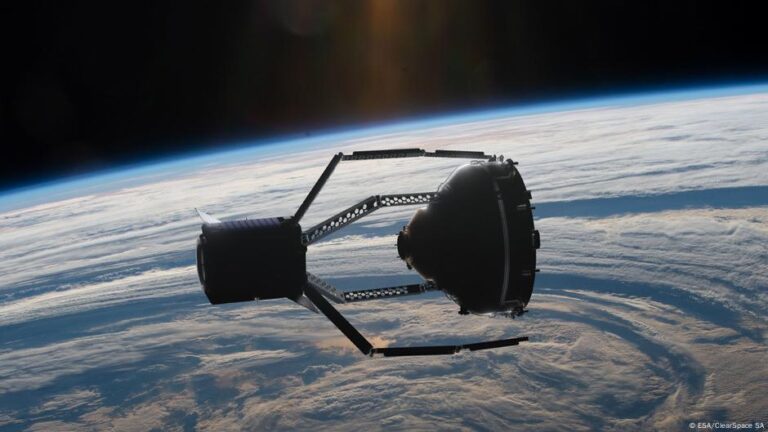Every year, at least one satellite is destroyed by a space junk collision. With more than 130 million pieces of debris now trapped in orbit around Earth, the European Space Agency (ESA) expects that figure to rise.
Combined with the increasing frequency of commercial space launches, which now account for most entries into Earth’s orbit, ESA is warning collisions with satellites could severely disrupt vital services like GPS services and environmental disaster monitoring.
Satellites orbiting Earth now make regular collision avoidance maneuvers to avoid damage to — or the destruction of — this critical space infrastructure. These avoidance maneuvers also impact astronauts onboard the International Space Station (ISS).
“We depend on satellites as a source of information for our daily life, from navigation, to telecommunications, to services, to Earth observation, including defense and security,” ESA Director General Josef Aschbacher told DW.
At its annual space debris conference, ESA called for swift action to clean up human-made junk — usually fragments of spacecraft or decommissioned satellites.
ESA has established a Zero Debris Charter, with 17 European nations signing on in 2023. Mexico and New Zealand joined last year.
A flying junkyard
The problem of debris is straightforward: Earth’s orbit is getting more crowded as more satellites arrive and dead technology is not removed.
Even the smallest pieces of space debris — measuring a millimeter in diameter — can cause major damage to functional spacecraft and satellites.
A decade ago, the Copernicus Sentinel-1A climate satellite suffered a 5cm-wide (1.9-inch) dent from a 2 millimeter space-junk projectile.
It didn’t affect the satellite’s operations, but it did highlight the risks of collisions with space debris. Larger objects could destroy entire satellites.
“A one-centimeter piece of debris has the energy of a hand grenade,” Tiago Soares, lead engineer of ESA’s Clean Space Office, told DW.
There are at least one million such bigger pieces of debris flying around Earth’s orbit today. Every collision risks creating hundreds more pieces of debris — a chain-reaction phenomenon known as the Kessler effect.
“That would be very disastrous and very damaging, because then whole orbits are made unusable. Therefore, whole categories of satellite usage would not be possible,” Aschbacher said.
An environmental problem above and below Earth
While all spacecraft are at risk of colliding with space junk, environmental monitoring satellites may be in the most immediate danger.
Satellites like the Copernicus Sentinels provide real-time monitoring of Earth’s climate and weather. They can also provide scientists and governments with vital data on natural disasters like wildfires and volcanic eruptions, droughts and floods.
If even one part of these satellite constellations were knocked out, it could severely disrupt the entire data-gathering operation.
“About 70% to 80% of all the [climate and environment] information that we get are from satellites. If those satellites in orbit are in danger, our ability to predict climate changes in the future […] is certainly under threat,” Aschbacher said.
“It’s not only the prediction, but also the mitigation of climate change, whether this is sea level rise, storms, hurricanes or other effects that are coming with global warming — the melting of ice caps, the melting of large ice areas, and so on,” he added.
Octopus arms to roadside service in space
A very small amount of space debris does fall back down to Earth, but the vast majority is trapped in orbit.
Fixing the problem of space junk is not simple, but space agencies are working on a variety of technologies that would, in some cases, pluck debris from space and return it to Earth.
No mission has achieved that feat yet, but ESA is scheduled to try with its ClearSpace-1 mission in 2028. The mission will use robotic arms to remove the suitcase-sized PROBA-1 satellite from low-Earth orbit.
Soares said other concepts include using a net-like structure to “fish” satellites out of orbit, but these are expensive — and as yet unproven — bits of equipment.
Another approach being considered is to create protocols to decommission unused space tech. Space agencies are researching methods to blast dead technology out of harm’s way with fuels supplies built into future spacecraft.
Other are looking into technology that would allow the controlled re-entry of redundant spacecraft back to Earth. The ESA is aiming to adopt the “reduce, reuse, recycle” mantra of environmental sustainability in space.
Rather than sending up space tows, it could be feasible to develop a kind of “roadside assistance” that performs repairs to satellites and extends their lifespan.
“We are looking, in the long-term, not only at removal, we are also looking at what we call the ‘circular economy in space,'” Soares said.
As he explained, that is “promoting new missions that are meant not just to remove the object from orbit, but to try to repair it and reuse parts and eventually even recycle them.”
Edited by: Fred Schwaller


